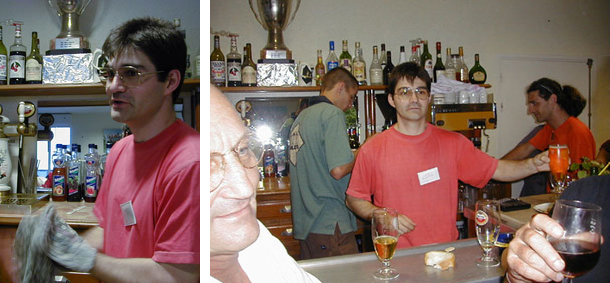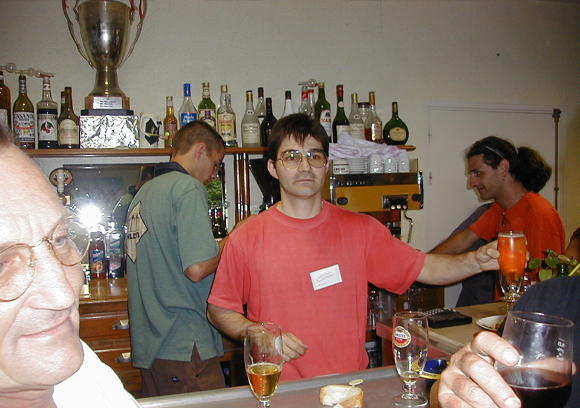| |
|
|
02.
| Barman |
| |


2000, badge.
Exhibition view from 10 familles, 10 artistes +si affinité, 2000, Fiac.
Courtesy of the artist.
'' The Barman performance invites us to be wary of appearances and to become aware of the mechanisms that underlie our perceptions and judgment of others.
It invites us to consider identity as a set of elements that are outside individuals, don’t really belong to them and aren’t sufficient to identify them. ''
Studio Fatmi, August 2017

Barman
Exhibition view from 10 familles, 10 artistes +si affinité, 2000, Fiac.
Courtesy of the artist.

Barman
Exhibition view from 10 familles, 10 artistes +si affinité, 2000, Fiac.
Courtesy of the artist.
|
|
|
|
|
|
Barman est une performance qui se déroule pendant le vernissage d'une exposition collective et qui met en scène un individu muni d'un badge où sont inscrits les nom et prénom de l'artiste. Le personnage se tient debout derrière le comptoir du bar et sert des boissons au public sans que ce dernier - qui dans sa grande majorité n'a jamais vu Mounir Fatmi et n'est donc pas capable de le reconnaître - soit averti de la substitution.
La performance questionne la notion d'identité en tant qu'ensemble d'éléments permettant de reconnaître une personne. A partir de l'étude de son fonctionnement et de ses effets dans l'espace social, Mounir Fatmi tente de définir son propre rapport à la question identitaire et d'établir une relation avec le public qui tienne compte de ses pouvoirs tout en la dépassant.
L'identité du personnage telle qu'elle se dévoile aux spectateurs se présente d'abord comme une combinaison d'éléments extérieurs ou visibles, dont la particularité est d'apparaître avec un caractère d'évidence : la position occupée dans l'espace, les nom et prénom, la fonction ou le métier, l'apparence physique et la tenue vestimentaire. Toutes ces données sont autant de marqueurs sociaux qui conditionnent les perceptions et entraînent des phénomènes de projections parmi le public assistant à la performance. Ces signes sont cependant associés avec malice : les nom et prénom annoncés ne semblent pas se rapporter à l'apparence physique perçue ; la position spatiale et l'activité à laquelle se livre le personnage entrent en contradiction avec sa désignation en tant qu'artiste censé se promener parmi les œuvres avec les spectateurs.
Ces phénomènes d'interférences entre marqueurs - pourtant proposés avec un aspect de certitude et d'univocité, finissent par brouiller les pistes et font naître un doute quant à la véritable identité du personnage et quant à la fiabilité desdits marqueurs afin de s'en informer. C'est la notion même d'identité, en tant qu'ensemble d'éléments individualisant et permettant de reconnaître une personne sans nulle confusion, qui est mise en doute.
La performance Barman invite à se méfier des apparences et à prendre conscience des mécanismes qui sont à l'origine de nos perceptions et de nos jugements sur autrui. Elle invite à considérer l'identité comme un ensemble d'éléments extérieurs à l'individu, ne lui appartenant pas vraiment, et qui ne suffisent pas à le définir. Mounir Fatmi prend ses distances avec l'identité comme construction sociale réalisée à partir de jugements et d'a priori réducteurs ou trompeurs. Il prend le parti du jeu, de la confusion et de la farce, contre les conditionnements sociaux, les évidences trompeuses et les étiquettes sociales qui tendent à figer les identités. Il remet du jeu dans la manière dont les marqueurs sociaux s'associent entre eux et dans le rapport que le spectateur entretient à sa propre individualité. Il prend enfin le parti du rire complice avec le public en l'invitant à déjouer avec lui les pièges de l'identité. .
Studio Fatmi, Août 2017. |
|
Barman is a performance that takes place during the vernissage of a collective exhibit and features an individual wearing a badge on which the artist’s first and last names are written. The character is standing behind the bar counter and serves drinks to audience members who aren’t aware of the substitution – the vast majority of them have never seen Mounir Fatmi and aren’t capable of recognizing him.
The performance questions the idea of identity as a set of elements allowing us to recognize a person. By studying the way it functions and its effects in the social sphere, Mounir Fatmi tries to define his own relation to the question of identity and to establish a relation with the audience that can acknowledge its power while going beyond it at the same time.
The character’s identity as revealed to the audience presents itself first and foremost as a combination of external, visible elements, with the particularity that they appear with a certain evidence: the person’s position in space, their name, job or function, their physical appearance and the way they’re dressed. All that information constitutes as many social indicators that condition our perceptions and trigger projections among the people watching the performance. But here, the signs are mischievously associated: the exhibited name doesn’t seem to match the character’s physical appearance; his position in space and his activity contradict his designation as the artist supposed to be walking around the exhibit with the viewers.
These phenomena of interferences between indicators – in spite of the fact they are offered with apparent certainty and univocity – blur the lines and arouse doubts regarding the character’s true identity and the reliability of those indicators as a source of information. It’s the entire notion of identity as a set of elements that individualize and allow us to recognize a person without any possible confusion that is called into question.
The Barman performance invites us to be wary of appearances and to become aware of the mechanisms that underlie our perceptions and judgment of others. It invites us to consider identity as a set of elements that are outside individuals, don’t really belong to them and aren’t sufficient to identify them. Mounir Fatmi distances himself from identity as a social construct built from judgments and reductive or misleading preconceptions. He chooses play, confusion and farce against social conditioning, false evidences and social labels that tend to congeal identities. He re-injects play into the way social indicators combine with each other and in the relation viewers entertain with their own individuality. Finally, he chooses to opt for a complicit joke with the audience members while inviting them to elude the pitfalls of identity.
Studio Fatmi, August 2017. |
|
|
|